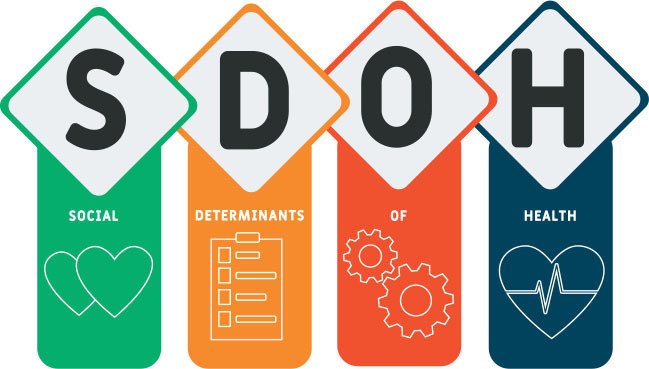
CalAIM — A Lesson in Transition
Healthcare providers and case managers encounter patients who experience a combination of barriers related to social determinants of health (SDoH) that make it difficult for patients to manage their chronic medical conditions such as chronic obstructive pulmonary disease (COPD), congestive heart failure (CHF), diabetes mellitus, hyperlipidemia, hypertension and depression. Managing these conditions can be difficult if they are socially frail, have unreliable transportation, caregiver needs, language barriers, lack of behavioral health resources, difficulty accessing nutritious foods and lack of affordable, stable and safe housing.
Population health is a model that aims to address these issues with population subsets. While population health interventions have been present through community health clinics, changes in their Medicaid benefits (also known as Medi-Cal in California), can lead to fragmentation in healthcare and social services. Without transportation or shelter, patients become overwhelmed or confused about how to access the resources, especially when lacking a primary care provider or having to suddenly change to a new primary care provider.
Social determinants of health such as food insecurity, employment and housing have had a more significant effect on population health since the COVID-19 pandemic. Contributing factors include rising rents, inflation, lack of computer/smart phone skills and the end of Medicaid continuous enrollment (Rudowitz, 2023).
To mitigate this problem, California recently implemented a new program in January 2023 — California Advancing and Innovating Medi-Cal (CalAIM) (CHCF, 2021). The state will eliminate fee-for-service (FFS) Medi-Cal for the majority and have individuals moved into a managed-care Medi-Cal plan (MCP) like Anthem Blue Cross or HealthNet. Individuals will be assigned to a provider in their community that can provide case management. The premise is that this support will help individuals overcome any barriers to health (i.e. SDoH) and eventually improve health and mental outcomes. According to the Department of Health Care Services, “CalAIM is moving Medi-Cal towards a population health approach that prioritizes prevention and whole person care. Our goal is to extend support and services beyond hospitals and healthcare settings directly into California communities. Our vision is to meet people where they are in life, address social drivers of health and break down the walls of healthcare. CalAIM will offer Medi-Cal enrollees coordinated and equitable access to services that address their physical, behavioral, developmental, dental and long-term care needs, throughout their lives, from birth to a dignified end of life” (Supporting Californians’ Ability to Stay Healthy in All Areas of Life, 2023). CalAIM’s primary target is the high-risk, high-cost patient. Its rearrangement in funding will transform and streamline managed care by moving patients from fee-for-service (straight) Medicaid to managed care Medicaid. It will expand financing and access for behavioral health services, notably for inpatient care that treat substance use disorders (SUD), severe mental illness (SMI) and severe emotional disturbance (SED). CalAIM also includes provisions of “in lieu of services” benefits to assist individuals in obtaining independence such as being assigned a housing navigator and ensuring that prisoners with medical conditions are provided Medi-Cal coverage in a timely manner after release. As expected, a sudden change to a massive system that has been in place for some time will have some pros and cons.
Some pros include the notification sent to members about the change to an MCP, and about the resources provided. DHCS sent out letters in October 2022, notifying Medi-Cal recipients of the upcoming change. DHCS expanded CalAIM campaign to (social) media on television and radio commercials, expanded availability of supportive services, enhanced coordination of care for medical and behavioral health services and direct linkage to community resources (transportation, food banks, etc.).
Some challenges were found during the transition. Patients failed to notify the county when they changed addresses and/or telephone numbers and they were randomly enrolled into one of the managed-care Medi-Cal plans. Individuals who have a primary care provider (PCP) that provides case management and/or are currently enrolled in a case management program were not excluded. More oversight of the transition among clinics was needed. More information is needed about the oversight on housing navigation and support and the ability of the clinics/housing navigator to meet demands for long-term or in-home support services. There are long wait times when attempting to contact the local Medi-Cal office, up to an hour or more.
The introduction of CalAIM requires that case managers be well informed on the CalAIM initiative to assist patients with the transition. The population facing the most disruption with this change is the elderly. This group has been well established with their PCP under Medicare and straight Medi-Cal. It has been challenging to grasp the new changes, not to mention adapting to a managed care plan that now requires more clinical justification when a referral is placed. The majority of these seniors are not only losing their long-term PCP, they also have to change the specialists they have been seeing. Some patients are already in a medical home that has an established case management program in their primary care provider’s office and would have to switch to a different case management program when going into the MCP.
To prevent a major disruption in care for patients with qualifying conditions, case managers can assist patients in applying for a medical exemption through Healthcare Options (DHCS, 2023). If approved, patients will receive a temporary exemption that must be renewed in 12 months. This process may take up to 6 weeks.
Implications for case managers to prepare patients for the transition to a MCP:
- Review your local Medi-Cal website for updates and contact information for you and your patients
- Attend information sessions on CalAIM
- Review the medical exemption application and process on the Healthcare Options website, to better assist your patients when needing to apply for a medical exemption and also to provide assistance in developing alternate plans in the event the exemption is denied
- Ensure patients have the understanding of the various methods to contact their Medi-Cal office to update any address changes so that they are notified as soon as possible of updates to Medi-Cal enrollment changes to their new MCP
- Educate the patient about population health management’s goals, CalAIM and empower the patient to contact their managed Medi-Cal plan to review its benefits (home-delivered meals, transportation to medical appointments, behavioral health services, housing navigator, etc.)
- Communicate with the current PCP office staff to obtain the most up to date MCP information for billing purposes to assist patients if they receive a bill they do not understand
- Initiate a dialogue with the patient’s primary care provider and their appropriate specialist to discuss the barriers the patient is facing if they lose their Medi-Cal fee-for-service.
- Empower the patient to discuss this change with their provider to avoid disruption in care and to avoid running out of medication
- Facilitate a warm hand-off between case managers
While the program offers solutions for individuals who lack a medical home, it remains to be seen whether CalAIM can indeed improve health outcomes, especially in populations that have had a well-established healthcare team and support. Also, it has yet to be determined whether the managed-care plans and the community clinics can successfully support the large number of individuals previously under fee-for-service Medi-Cal. CalAIM strives to provide a more expanded and coordinated program to Medi-Cal members. Without coordination, the tools to address barriers cannot be used at its full force. Case managers and primary care provider offices must work together to ensure patients have a smooth transition to the new program and to assist vulnerable patients from being lost to care.
REFERENCES
California Department of Health Care Services. (2023). Supporting Californians’ Ability to Stay Healthy in All Areas of Life. Dhcs.ca.gov. https://www.dhcs.ca.gov/CalAIM/Pages/calaim.aspx.
California Health Care Foundation (CHCF) (2021, July 26). CalAIM explained: a 5 year plan to transform Medi-Cal. https://www.chcf.org/publication/calaim-explained-five-year-plan-transform-medi-cal/#what-is-calaim.
Department of Health Care Services (DHCS), (2023). MediCal Managed Care Health Care Options – download forms. https://www.healthcareoptions.dhcs.ca.gov/en/download-forms.
Rudowitz, R., Burns, A. et al (2023, January 24). Medicaid: What to watch in 2023. Kaiser Family Foundation (KFF). https://www.kff.org/medicaid/issue-brief/medicaid-what-to-watch-in-2023/.
Image credit: ISTOCK.COM/NADEZHDA KOZHEDUB






